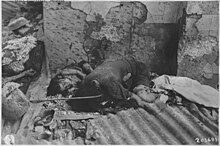Manila massacre

The Manila massacre involved the killings of at least 100,000 Filipino civilians in the city of Manila, Philippines by the Japanese troops in the Battle of Manila during World War II. The Manila massacre was one of several major war crimes committed by the Imperial Japanese Army, as judged by the postwar military tribunal. The Japanese commanding general Tomoyuki Yamashita and his chief of staff Akira Mutō were held responsible for the massacre in a trial in late 1945 in Manila, Yamashita was executed on 23 February 1946 and Muto on 23 December 1948.
Description

To preserve as large a force as possible to continue defensive operations in rural Luzon of the Philippines, General Tomoyuki Yamashita had insisted on a complete withdrawal of Japanese troops from Manila in January, 1945. However, this was not realized because of objections from Imperial Japan headquarters. 10,000 Japanese marines under Vice Admiral Iwabuchi Sanji remained in Manila along with 4000 Japanese army stragglers.
One Japanese order read, "The Americans who have penetrated into Manila have about 1000 troops, and there are several thousand Filipino guerrillas. Even women and children have become guerrillas. All people on the battlefield with the exception of Japanese military personnel, Japanese civilians, Special Construction Units, will be put to death."[1]: 107–108
Dr Antonio Gisbert told of the murder of his father and brother at the Palacio del Gobernador, saying, "I am one of those few survivors, not more than 50 in all out of more than 3000 men herded into Fort Santiago and, two days later, massacred.[1]: 110
A Japanese order dated 13 Feb. 1945, read, "When Filipinos are to be killed, they must be gathered into one place and disposed of with the consideration that ammunition and manpower must not be used to excess. Because the disposal of dead bodies is a troublesome task, they should be gathered into houses which are scheduled to be burned or demolished. They should also be thrown into the river."[1]: 130
In the Battle of Manila, the United States Army and the Philippine Commonwealth Army advanced into the city of Manila to drive out the Japanese. During lulls in the battle for control of the city, Japanese troops took out their anger and frustration on the innocent civilians in the city; various credible Western and Eastern sources agree that the death toll of the Manila Massacre was at least 100,000 to 120,000 including children and babies brutally killed by the Japanese,[2] tallying to around 10% of the population of the city.
Massacres occurred in schools, hospitals and convents, including San Juan de Dios Hospital, Santa Rosa College, Santo Domingo Church, Manila Cathedral, Paco Church, St. Paul's Convent, and St. Vincent de Paul Church.[1]: 113
See also
Notes
References
- Taylor, Lawrence. A Trial of Generals. Icarus Press, South Bend IN, 1981
- Quezon, Taylor (7 February 2007). "The Warsaw of Asia: How Manila Was Flattened in WWII". Arab News. Retrieved 25 January 2011.
External links
- WW2DB: The Philippines Campaign
- The Battling Bastards of Bataan
- The Historical Atlas of the Twentieth Century by Matthew White
- Use dmy dates from September 2011
- World War II massacres
- Massacres in the Philippines
- Massacres committed by Japan
- History of Manila
- 1945 in Japan
- 1945 in the Philippines
- Conflicts in 1945
- War crimes in the Philippines
- Military history of the Philippines during World War II
- Philippine Commonwealth Army
- Mass murder in 1945
